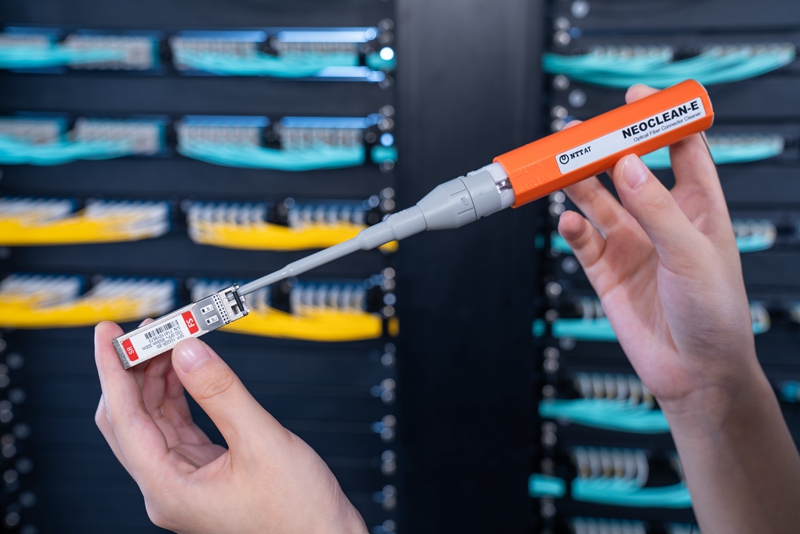Why My SFP Transceiver Isn't Working?
When SFP failure occurs, it's important for technicians to figure out the reason immediately and repair it, otherwise, the 1 Gigabit link may break out. This guide will assist in supplying a number of SFP transceiver repair solutions for a newbie into the transceiver globe.
The Main Causes of SFP Module Failures
SFP optical module failure usually occurs in two ways, the transmitting end and the receiving end. And the most common problems are mainly concentrated in the following aspects:
Optical Slots Contamination and Damages
There are several reasons to cause SFP optical slot failurfes. For example, SFP ports are exposed to the environment in long time and contaminated by dust, or using a fiber cable with contaminated end face to connenct the SFP optical transceiver may result in secondary pollution. In addition, connecting scratched or poor-quality fiber cables to 1g SFP modules will also make the SFP fiber transceiver break out. These SFP failures will lead to transmission interruption, then your 1 gigabit link can not work properly.
ESD Damages
The optical module is damaged by ESD (Electrostatic Discharge). ESD will absorb dust, change the impedance between lines, and affect the function and life of the 1000Base SFP transceiver module. Two factors will case ESD damage. For one, ESD may produced in dry environment. For another one, 1000Base transceivers are not packed with anti-static packages, or the static sensitive pins are not touched bystatic electricity protection. As a result, SFP optical modules can not work in regular manners.
Compatibility Issues
Other than the aspects above, sfp compatibility issues can not be ignored. If technicians plug one SFP module into SFP+ port, or installing 1310nm SFP transceiver on side A and an 850 nm transceiver on side B, all will lead to compatibility issues. Besides, although most sellers guarantee 100% compatibility of their sfp modules, which might not be the scenario. Technicians must ensure the SFP module is compatible with their devices before buying.
Tips for Solving SFP Failures
Optical Interface Protection
To protect SFP ports from dust damage, it's wise to use a dust plug on unused 1000Base SFP optical transceivers. Before connecting fiber cables, using pen cleaners to clean the interface of both fibers and SFPs is preferred.

-
Handle optical modules gently and protect them from falling.
-
When installing an optical module, push it gently by hand. When removing an optical module, unlatch it first. Never use any metal tools during installation and removal.
-
Use a dedicated cotton swab to clean an optical bore and do not insert any metal object into it.
ESD Prevention
The following are some tips for 1GB SFP modules avoiding EDS prevention.
-
When you transport optical modules, ensure that they are in ESD packages, and do not take them out unless necessary or place them at random.
-
Before touching an optical module, wear an ESD wrist strap or ESD gloves. Take full ESD measures when installing it.
-
Ensure that a device is properly grounded before you test or use it.
-
When plugging in and out non-hot-swap optical module, you should cut off the power.
Compatibility Troubleshooting
Following the below tips can help avoid some compatibility issues.
-
Check you’re plugging SFP or SFP+ transceivers and into the right slots. SFP and SFP+ modules share the same size, and SFP transceiver will fit seamlessly into an SFP+ switch port and vice versa. But remember that installing an SFP+ module into an SFP port delivers no results, since the 10G transceiver may not auto-negotiate to 1Gbps.
-
Make sure that the SFPs have identical wavelengths at both ends. Besides, please check the SFP optical module matches the right optical fibers. For example, 1310nm single mode SFP must work with single mode fibers, and for 850nm multimode SFP modules need to use multimode cables for connections. Mixed usage will cause signal loss and other SFP failures./p>
-
Ensure SFP ethernet module can match well with your devices. Some brands only allow to use their own modules. Because all transceivers actually have a burned-in chip containing information including the serial quantity, the safety information, plus the vendor ID. If the information cannot match what exactly is within the database, these devices will undoubtedly be handicapped making these devices stop working.

How Can I Judge If the SFP Module Is Working?
-
Test whether the optical power is within the required range. If there is no light or low optical power, you should check the wavelength and measurement unit (dBm). Clean and check the end face of the optical fiber connector and optical port of the optical module,whether the end face of the optical fiber connector is black ,scratched or bends, and then replace the optical fiber connector or optical module for interchangeability test.
-
The optical power is normal, but the link cannot be connected. Check the link light. This problem pertains to the cabling. The application of bad or wrong cable, wrong cable wiring, or a cable having loops, may lead to this sort of issue.
-
The slot is put in an error-disabled state (corrupted software) after the SFP is inserted, eliminate the SFP transceiver from the slot and change it with an authorized module. If it does not recognize the SFP Module, verify your module just isn’t inserted upside down, check the module slot, or replace an authorized module for interchangeability test.
-
You might be interested in
Email Address

-
PoE vs PoE+ vs PoE++ Switch: How to Choose?
Mar 16, 2023














